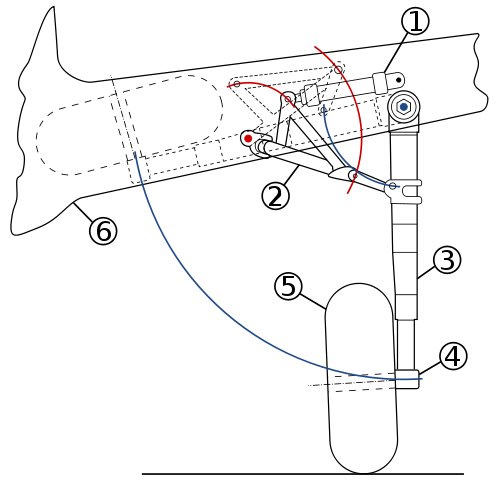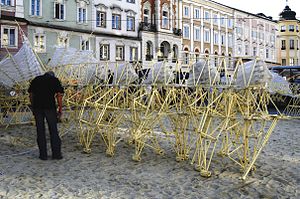- Mechanism (engineering)
-
A mechanism is a device designed to transform input forces and movement into a desired set of output forces and movement. Mechanisms generally consist of moving components such as gears and gear trains, belt and chain drives, cam and follower mechanisms, and linkages as well as friction devices such as brakes and clutches, and structural components such as the frame, fasteners, bearings, springs, lubricants and seals, as well as a variety of specialized machine elements such as splines, pins and keys.[1]
The German scientist Reuleaux[2] provides the definition "a machine is a combination of resistant bodies so arranged that by their means the mechanical forces of nature can be compelled to do work accompanied by certain determinate motion."[3] In this context, his use of machine is generally interpreted to mean mechanism.
The combination of force and movement defines power, and a mechanism is designed to manage power in order to achieve a desired set of forces and movement.
A mechanism is usually a piece of a larger process or mechanical system. Sometimes an entire machine may be referred to as a mechanism. Examples are the steering mechanism in a car, or the winding mechanism of a wristwatch. Multiple mechanisms are machines.
Contents
Types of Mechanisms
From the time of Archimedes through the Renaissance, mechanisms were considered to be constructed from simple machines, such as the lever, pulley, screw, wheel and axle, wedge and inclined plane. It was Reuleaux who focussed on bodies, called links, and the connections between these bodies called kinematic pairs, or joints.
In order to use geometry to study the movement a mechanism, its links are modeled as rigid bodies. This means distances between points in a link are assumed to be unchanged as the mechanism moves, that is the link does not flex. Thus, the relative movement between points in two connected links is considered to result from the kinematic pair that joins them.
Kinematic pairs, or joints, are considered to provide ideal constraints between two links, such as the constraint of a single point for pure rotation, or the constraint of a line for pure sliding, as well as pure rolling without slipping and point contact with slipping. A mechanism is modeled as an assembly of rigid links and kinematic pairs.
Kinematic pairs
Reuleaux called the ideal connections between links 'kinematic pairs. He distinguished between higher pairs which were said to have line contact between the two links and lower pairs that have area contact between the links. J. Phillips[4] shows that there are many ways to construct pairs that do not fit this simple classification.
Lower pair: A lower pair is an ideal joint that constrains contact between a point, line or plane in the moving body to a corresponding point line or plane in the fixed body. We have the following cases:
- A revolute pair, or hinged joint, requires a line in the moving body to remain co-linear with a line in the fixed body, and a plane perpendicular to this line in the moving body maintain contact with a similar perpendicular plane in the fixed body. This imposes five constraints on the relative movement of the links, which therefore has one degree of freedom.
- A prismatic joint, or slider, requires that a line in the moving body remain co-linear with a line in the fixed body, and a plane parallel to this line in the moving body maintain contact with a similar parallel plan in the fixed body. This imposes five constraints on the relative movement of the links, which therefore has one degree of freedom.
- A cylindrical joint requires that a line in the moving body remain co-linear with a line in the fixed body. It is a combination of a revolute joint and a sliding joint. This joint has two degrees of freedom.
- A spherical joint, or ball joint, requires that a point in the moving body maintain contact with a point in the fixed body. This joint has three degrees of freedom.
- A planar joint requires that a plane in the moving body maintain contact with a plane in fixed body. This joint has three degrees of freedom.
Higher pairs: Generally, a higher pair is a constraint that requires a curve or surface in the moving body to maintain contact with a curve or surface in the fixed body. For example, the contact between a cam and its follower is a higher pair called a cam joint. Similarly, the contact between the involute curves that form the meshing teeth of two gears are cam joints.
Gears and gear trains
 Gears are a type of mechanism.
Gears are a type of mechanism.
The transmission of rotation between contacting toothed wheels can be traced back to the Antikythera mechanism of Greece and the South Pointing Chariot of China. Illustrations by the renaissance scientist Georgius Agricola show gear trains with cylindrical teeth. The implementation of the involute tooth yielded a standard gear design that provides a constant speed ratio. Some important features of gears and gear trains are:
- The ratio of the pitch circles of mating gears defines the speed ratio and the mechanical advantage of the gear set.
- A planetary gear train provides high gear reduction in a compact package.
- It is possible to design gear teeth for gears that are non-circular, yet still transmit torque smoothly.
- The speed ratios of chain and belt drives are computed in the same way as gear ratios. See bicycle gearing.
Cam and follower mechanisms
A cam and follower is formed by the direct contact of two specially shaped links. The driving link is called the cam (also see cam shaft) and the link that is driven through the direct contact of their surfaces is called the follower. The shape of the contacting surfaces of the cam and follower determines the movement of the mechanism.
Linkages
A linkage is a collection of links connected by joints. Generally, the links are the structural elements and the joints allow movement. Perhaps the single most useful example is the planar four-bar linkage. However, there are many more special linkages:
- Watt's linkage is a four-bar linkage that generates an approximate straight line. It was critical to the operation of his design for the steam engine. This linkage also appears in vehicle suspensions to prevent side-to-side movement of the body relative to the wheels. Also see the article Parallel motion.
- The success of Watt's linkage lead to the design of similar approximate straight-line linkages, such as Hoeken's linkage and Chebyshev's linkage.
- The Peaucellier linkage generates a true straight-line output from a rotary input.
- The Sarrus linkage is a spatial linkage that generates straight-line movement from a rotary input.
- The Klann linkage and the Jansen linkage are recent inventions that provide interesting walking movements. They are respectively a six-bar and an eight-bar linkage.
Flexure mechanisms
A flexure mechanism consisted of a series of rigid bodies connected by compliant elements (flexure bearings also known as flexure joints) that is designed to produce a geometrically well-defined motion upon application of a force.
See also
- Linkage (mechanical)
- Four-bar linkage
- Machine (mechanical)
- Mechanical system
- Mechanical watch
- Virtual work
- Gear
- Gear train
- Gear ratio
References
- ^ J. J. Uicker, G. R. Pennock, and J. E. Shigley, 2003, Theory of Machines and Mechanisms, Oxford University Press, New York.
- ^ Reuleaux, F., 1876 'The Kinematics of Machinery,' (trans. and annotated by A. B. W. Kennedy), reprinted by Dover, New York (1963)
- ^ Eckhardt, Homer. Kinematic Design of Machines and Mechanisms. McGrawHill. ISBN 0-07-018953.
- ^ J. Phillips, Freedom in Machinery, Cambridge University Press, 2006
External links
- Balanced hinge-lever mechanism
- 507 Mechanical Movements a 1908 publication by Henry T. Brown
Categories:- Kinematics
- Machines
- Mechanisms
Wikimedia Foundation. 2010.


